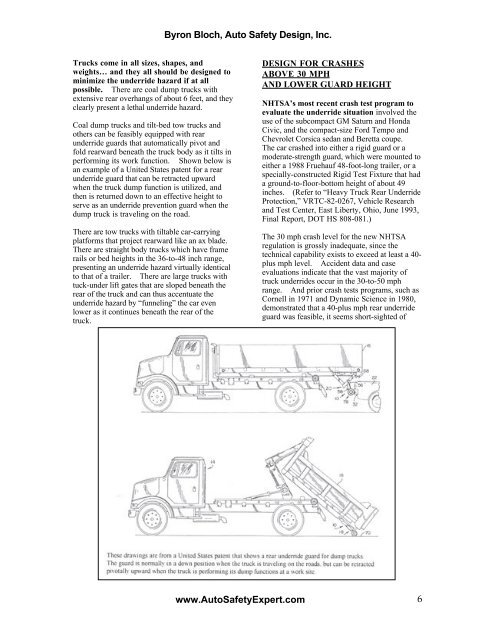Underride Protection
Formula 1 UNDERUN SAFETY A MUST
Formula 1 UNDERUN SAFETY A MUST
Create successful ePaper yourself
Turn your PDF publications into a flip-book with our unique Google optimized e-Paper software.
Byron Bloch, Auto Safety Design, Inc.<br />
Trucks come in all sizes, shapes, and<br />
weights… and they all should be designed to<br />
minimize the underride hazard if at all<br />
possible. There are coal dump trucks with<br />
extensive rear overhangs of about 6 feet, and they<br />
clearly present a lethal underride hazard.<br />
Coal dump trucks and tilt-bed tow trucks and<br />
others can be feasibly equipped with rear<br />
underride guards that automatically pivot and<br />
fold rearward beneath the truck body as it tilts in<br />
performing its work function. Shown below is<br />
an example of a United States patent for a rear<br />
underride guard that can be retracted upward<br />
when the truck dump function is utilized, and<br />
then is returned down to an effective height to<br />
serve as an underride prevention guard when the<br />
dump truck is traveling on the road.<br />
There are tow trucks with tiltable car-carrying<br />
platforms that project rearward like an ax blade.<br />
There are straight body trucks which have frame<br />
rails or bed heights in the 36-to-48 inch range,<br />
presenting an underride hazard virtually identical<br />
to that of a trailer. There are large trucks with<br />
tuck-under lift gates that are sloped beneath the<br />
rear of the truck and can thus accentuate the<br />
underride hazard by “funneling” the car even<br />
lower as it continues beneath the rear of the<br />
truck.<br />
DESIGN FOR CRASHES<br />
ABOVE 30 MPH<br />
AND LOWER GUARD HEIGHT<br />
NHTSA’s most recent crash test program to<br />
evaluate the underride situation involved the<br />
use of the subcompact GM Saturn and Honda<br />
Civic, and the compact-size Ford Tempo and<br />
Chevrolet Corsica sedan and Beretta coupe.<br />
The car crashed into either a rigid guard or a<br />
moderate-strength guard, which were mounted to<br />
either a 1988 Fruehauf 48-foot-long trailer, or a<br />
specially-constructed Rigid Test Fixture that had<br />
a ground-to-floor-bottom height of about 49<br />
inches. (Refer to “Heavy Truck Rear <strong>Underride</strong><br />
<strong>Protection</strong>,” VRTC-82-0267, Vehicle Research<br />
and Test Center, East Liberty, Ohio, June 1993,<br />
Final Report, DOT HS 808-081.)<br />
The 30 mph crash level for the new NHTSA<br />
regulation is grossly inadequate, since the<br />
technical capability exists to exceed at least a 40-<br />
plus mph level. Accident data and case<br />
evaluations indicate that the vast majority of<br />
truck underrides occur in the 30-to-50 mph<br />
range. And prior crash tests programs, such as<br />
Cornell in 1971 and Dynamic Science in 1980,<br />
demonstrated that a 40-plus mph rear underride<br />
guard was feasible, it seems short-sighted of<br />
www.AutoSafetyExpert.com 6


